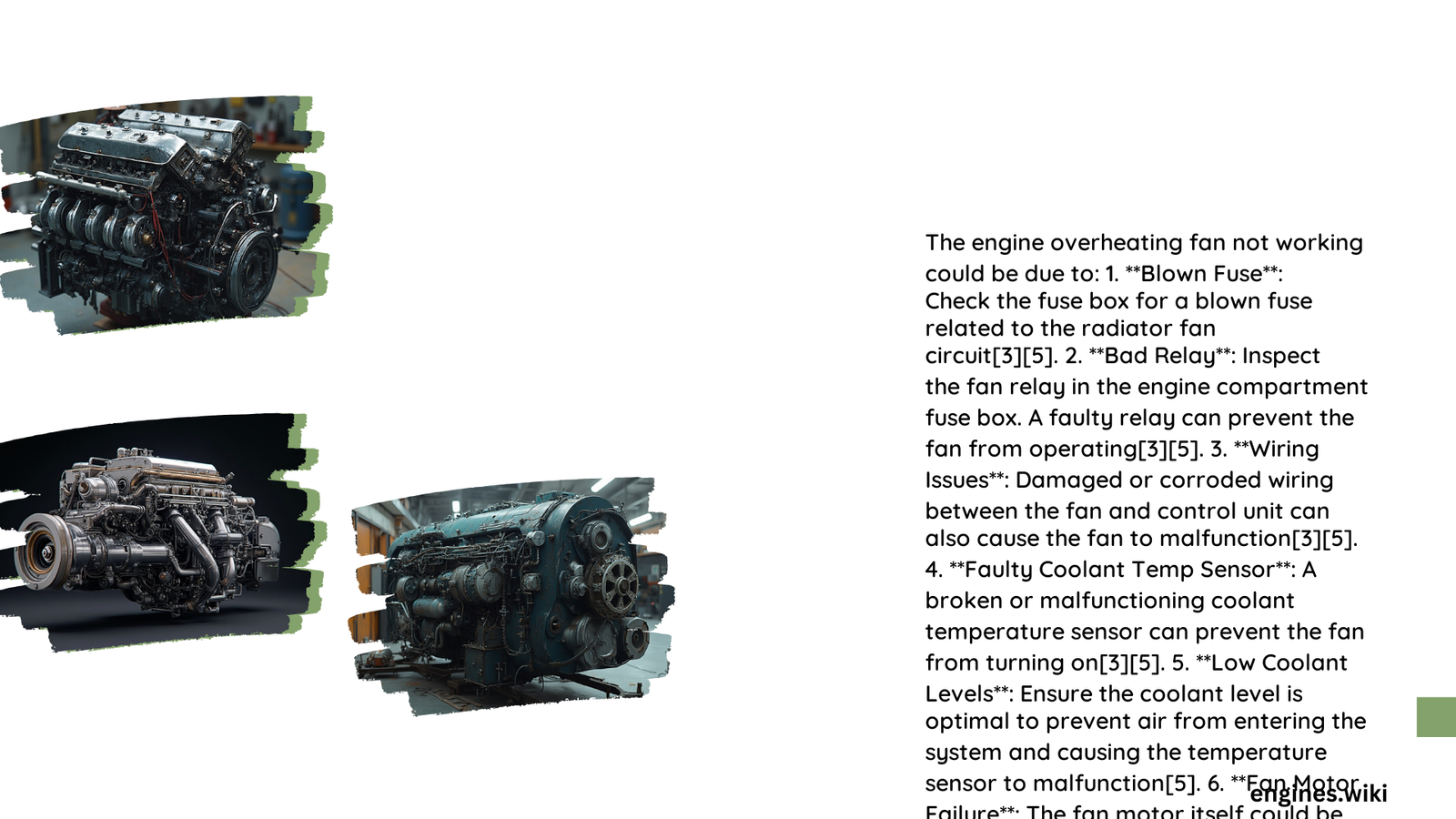When an engine cooling fan fails to operate, it can lead to severe overheating issues. This problem often manifests as rising engine temperatures, especially during idle or low-speed driving. A malfunctioning cooling fan can cause the engine to overheat, potentially resulting in significant damage if not addressed promptly. Understanding the symptoms, causes, and solutions for a non-working cooling fan is crucial for maintaining your vehicle’s health and preventing costly repairs.
What Are the Main Symptoms of Engine Overheating Due to Fan Failure?
The primary indicators of engine overheating caused by a non-functioning cooling fan include:
- Rapidly increasing engine temperature
- Temperature warning light illumination
- Steam emanating from under the hood
- Unusual engine noises
- Decreased engine performance
These symptoms often become more pronounced when the vehicle is stationary or moving at low speeds, as airflow through the radiator is reduced in these conditions.
Why Does the Engine Cooling Fan Stop Working?

Several factors can contribute to the failure of an engine cooling fan:
- Electrical Issues:
- Blown fuses
- Faulty wiring
-
Damaged connectors
-
Mechanical Problems:
- Worn-out fan motor
- Broken fan blades
-
Seized bearings
-
Control System Failures:
- Malfunctioning temperature sensors
- Defective fan relay
-
Compromised engine control module (ECM)
-
Coolant System Issues:
- Low coolant levels
- Coolant leaks
- Blocked radiator
How Can You Diagnose a Non-Working Engine Cooling Fan?
To identify the root cause of a non-functioning cooling fan, follow these diagnostic steps:
- Visual Inspection:
- Check for visible damage to fan blades or wiring
-
Look for coolant leaks or low coolant levels
-
Electrical Testing:
- Use a multimeter to test the fan motor for proper voltage
-
Check fuses and relays related to the cooling system
-
OBD-II Scanning:
- Connect an OBD-II scanner to check for error codes
-
Look for codes related to the cooling system or fan operation
-
Temperature Monitoring:
- Observe engine temperature during various driving conditions
-
Note when the temperature rises abnormally
-
Fan Activation Test:
- Manually activate the fan using a jumper wire or scan tool
- Verify if the fan responds to direct power application
What Are the Potential Consequences of Ignoring a Faulty Cooling Fan?
Neglecting a non-working cooling fan can lead to severe engine damage:
| Consequence | Description | Potential Cost |
|---|---|---|
| Engine Overheating | Excessive heat can warp cylinder heads and damage gaskets | $1,000 – $4,000 |
| Blown Head Gasket | Failure of the seal between engine block and cylinder head | $1,500 – $3,000 |
| Cracked Engine Block | Severe overheating can cause the engine block to crack | $3,000 – $5,000+ |
| Seized Engine | Complete engine failure due to extreme heat | $5,000 – $10,000+ |
How Can You Fix an Engine Cooling Fan That’s Not Working?
Depending on the underlying cause, here are some potential solutions:
- Replace Blown Fuses:
-
Locate the fuse box and replace any blown fuses related to the cooling system
-
Repair or Replace Wiring:
-
Inspect wiring for damage and repair or replace as necessary
-
Replace Fan Motor:
-
If the motor is faulty, replace it with a new unit
-
Clean or Replace Radiator:
-
Remove debris from the radiator or replace if severely damaged
-
Replace Temperature Sensor:
-
Install a new sensor if the current one is malfunctioning
-
Repair Coolant Leaks:
-
Identify and fix any coolant leaks in the system
-
Replace Fan Relay:
- If the relay is defective, replace it with a new one
What Preventive Measures Can You Take to Avoid Cooling Fan Failures?
To minimize the risk of cooling fan issues:
- Regular Maintenance:
- Follow the manufacturer’s recommended maintenance schedule
-
Perform routine coolant system checks
-
Keep the Radiator Clean:
-
Remove debris and clean the radiator periodically
-
Monitor Engine Temperature:
-
Pay attention to the temperature gauge during normal operation
-
Address Warning Signs Promptly:
-
Investigate any unusual noises or temperature fluctuations immediately
-
Use Quality Parts:
- When replacing components, opt for high-quality, OEM-approved parts
How Much Does It Cost to Repair or Replace an Engine Cooling Fan?
The cost of repairing or replacing an engine cooling fan can vary:
| Repair/Replacement | Estimated Cost Range |
|---|---|
| Fuse Replacement | $10 – $20 |
| Fan Motor Replacement | $200 – $600 |
| Complete Fan Assembly | $300 – $800 |
| Wiring Repair | $100 – $300 |
| Temperature Sensor Replacement | $100 – $250 |
| Fan Relay Replacement | $50 – $150 |
Note: These are approximate costs and can vary based on vehicle make, model, and location.
Can You Drive with a Non-Working Engine Cooling Fan?
It is not recommended to drive with a non-functioning engine cooling fan. Doing so can lead to:
- Rapid engine overheating
- Potential engine damage
- Breakdown in traffic
- Costly repairs
If you must drive, do so for very short distances and monitor the temperature gauge closely. Seek professional help immediately to address the issue.
By understanding the causes, symptoms, and solutions for a non-working engine cooling fan, you can better maintain your vehicle and prevent potentially catastrophic engine damage. Regular maintenance and prompt attention to warning signs are key to ensuring your engine’s cooling system functions properly, keeping your vehicle running smoothly and reliably.
References:
1. RepairPal – Signs of a Failing Radiator Fan: Symptoms & Repair Tips
2. YouTube – Backyard Mechanic: 5 Symptoms of a Bad Radiator Cooling Fan
3. Grimmer Motors – When to Replace a Radiator Cooling Fan – Signs & Symptoms
4. CarParts.com – How to Replace a Radiator Fan
5. AutoZone – How to Test and Replace Your Radiator Fan
